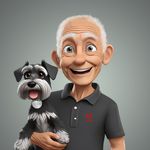- Home
- Photoshop ecosystem
- Discussions
- Re: How to - Photo Compositing / Double Exposure
- Re: How to - Photo Compositing / Double Exposure
Copy link to clipboard
Copied
Photo Compositing (double exposure) a blurred + in-focus image
1. Select an existing photo or shoot a new one.
If shooting, leave room for the 2nd image.
If using an existing photo, extend the canvas & Content Aware Fill the blank canvas area.
2. Duplicate the image or take a 2nd shot.
If taking a 2nd shot blur it by shooting it out of focus.
If using a duplicate, blur the Duplicate with Gaussian or Lens Blur?
3. Load the 2 images as layers & select a Blend Mode (?) or Blend If and adjust Opacity to reveal both
4. Use the Move tool to drag top image away from the bottom
 1 Correct answer
1 Correct answer
Hi Frank. I made the background layer black so that the image layers would fade into it. As you can see, white does not work so well nor is it as aesthetically pleasing. It's your project, and only you know the intended end use.
I'm still not 100% clear on "so I could use another layer mask to blend in the top layer to the copied layeer below"
By @frankg_photos
We need to cut out the head shot from its background which I did in about 10 seconds with Select Subject > Select & Mask (Refin
Explore related tutorials & articles
Copy link to clipboard
Copied
The examples you posted might rely on Layer Masks more than on Blend Modes.
Copy link to clipboard
Copied
Photoshop is so good with selections nowadays, thiese sort of effects are super easy. Simply selecting the Quick Select tool and clicking Select Subject in the Options bar made a near perfect selection in the example below. I chose to output to a new layer with layer mask, and then make that a Smart Object so I could use another layer mask to blend in the top layer to the copied layeer below. In this case I used some Gaussian blur and set layer opacity to 50%, but there are near infinite choises you can make, and especially if you work with Smart Objects so you can adjust effects or turn them off.
Copy link to clipboard
Copied
@Trevor.Dennis OK I think I get it now. Is the bottom/bkgrd layer black because the subject was not originally shot on black & you had to isolate/select him - I didn't get that at first? Then you have the blurred layer & the bigger/foreground layer on top with a layer mask. I'm still not 100% clear on "so I could use another layer mask to blend in the top layer to the copied layeer below"
Copy link to clipboard
Copied
Hi Frank. I made the background layer black so that the image layers would fade into it. As you can see, white does not work so well nor is it as aesthetically pleasing. It's your project, and only you know the intended end use.
I'm still not 100% clear on "so I could use another layer mask to blend in the top layer to the copied layeer below"
By @frankg_photos
We need to cut out the head shot from its background which I did in about 10 seconds with Select Subject > Select & Mask (Refine hair) and output to layer with layer mask. That layer mask is now in our way so we have several options on how to consolidate it.
Right click the mask and choose Apply mask
Right click the layer and make it a Smart Object
I chose Apply Layer mask so we now have the cut out layer with no mask.
That allowed me to add another layer mask, and run a black to white or transparent gradient across the mask making the layer fade into whatever layers are lower down the layer stack.
Selections and masks are probably the most important skills to master if you are going to use Photoshop creatively. It's a lot of fun and you'll never get bored with it.
Copy link to clipboard
Copied
Thank you!
Copy link to clipboard
Copied
Is there a reason why you have to make that image with Photoshop?
You can make it Photoshop, but you can make it simple by placing an object such as a prism in front of the camera during the filming stage. You can control the effects as much as you want and even the proportion of the screen.
Why do you think this is Compositing? Most of them are possible in the filming stage, and they are done in the filming stage.
Copy link to clipboard
Copied
Is there a reason why you have to make that image with Photoshop?
In case touch-up is required it might be easier to do that in the Smart Object and have it upate in both instances than to do it twice in an actual photograph.
Copy link to clipboard
Copied
I understand what're you talking about.
But what I'm saying to the author is, "Why do you want to photoshop this?"
Ninety-nine of the 100 shots prepare a prism in advance in the field. There is no need for a large prism, so even a prism smaller than the palm is enough to produce the effect the writer wants.
Of course, it may be a thread that came up because I wanted to apply such an effect later because I couldn't do it during filming, but the explanation with this post authors is already wrong from the premise. That's why I'm talking. It's not Compositing. It is difficult for the author to misunderstand and approach what is not compositing as compositing.
Copy link to clipboard
Copied
Intrigued.... is there a video on YouTube showcasing this technique........
Copy link to clipboard
Copied
No idea if there's a video. Post the link here if you find one. As all the replies have indicated, there are several different ways to get the look.
Copy link to clipboard
Copied
The more polygons that are not normal shapes, the more shapes you can make.
If you just take a normal prism at an angle, you can take it like a mirror (like the example picture), If you bring the prism close to the camera lens, you can get a little bokey effect, and if you move away, you can get a mirroring or scattering effect related to the subject of the thread.
Find more inspiration, events, and resources on the new Adobe Community
Explore Now









